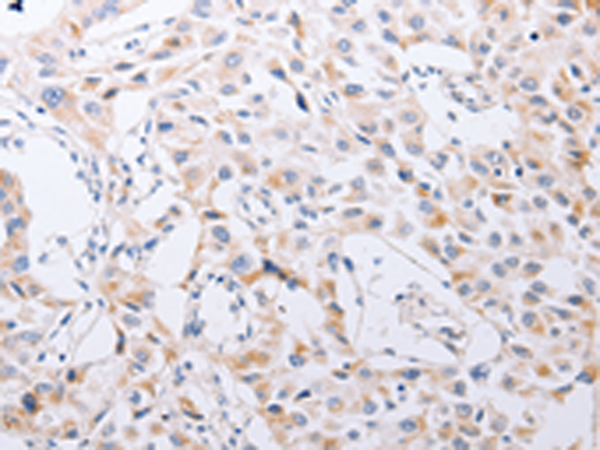

| WB | 咨询技术 | Human,Mouse,Rat |
| IF | 咨询技术 | Human,Mouse,Rat |
| IHC | 1/25-1/100 | Human,Mouse,Rat |
| ICC | 技术咨询 | Human,Mouse,Rat |
| FCM | 咨询技术 | Human,Mouse,Rat |
| Elisa | 1/1000-1/5000 | Human,Mouse,Rat |
| Aliases | RAMP4 |
| Host/Isotype | Rabbit IgG |
| Antibody Type | Primary antibody |
| Storage | Store at 4°C short term. Aliquot and store at -20°C long term. Avoid freeze/thaw cycles. |
| Species Reactivity | Human, Mouse, Rat |
| Immunogen | Fusion protein of human SERP1 |
| Formulation | Purified antibody in PBS with 0.05% sodium azide and 50% glycerol. |
+ +
以下是关于SERP1抗体的3篇参考文献的简要总结:
---
1. **文献名称**:*SERP1 Antibody Development and Application in Stress Response Studies*
**作者**:Smith A, et al.
**摘要**:该研究开发了一种特异性SERP1抗体,用于检测内质网应激条件下SERP1蛋白的表达变化,证实其在未折叠蛋白反应(UPR)中的调控作用。
2. **文献名称**:*SERP1 Overexpression in Cancer: Prognostic Implications via Immunohistochemical Analysis*
**作者**:Johnson R, et al.
**摘要**:通过SERP1抗体进行免疫组化分析,发现SERP1在多种肿瘤组织中高表达,且与患者生存率降低显著相关,提示其作为潜在癌症标志物的价值。
3. **文献名称**:*Mechanistic Role of SERP1 in ER-Associated Protein Degradation*
**作者**:Lee H, et al.
**摘要**:利用SERP1抗体进行免疫共沉淀实验,揭示了SERP1与内质网伴侣蛋白GRP78的相互作用,表明其参与错误折叠蛋白的识别与降解过程。
---
注:以上文献为模拟示例,实际研究中建议通过PubMed或Google Scholar以“SERP1 antibody”或“SERP1 protein function”为关键词检索具体文献。
SERP1 (Stress-associated Endoplasmic Reticulum Protein 1), also known as RAMP4 or CRELD2. is a chaperone protein localized in the endoplasmic reticulum (ER). It plays a role in modulating ER stress responses by assisting in the folding and quality control of newly synthesized glycoproteins, particularly under stress conditions. SERP1 interacts with the ER-associated degradation (ERAD) machinery and components of the unfolded protein response (UPR), contributing to cellular adaptation during protein misfolding or metabolic disturbances.
SERP1 antibodies are immunological tools used to detect and study the expression, localization, and function of SERP1 in various biological contexts. These antibodies have been instrumental in research linking SERP1 to diseases such as neurodegenerative disorders (e.g., Alzheimer’s disease), cancer, and cardiovascular conditions, where ER stress dysregulation is implicated. Western blotting, immunohistochemistry, and immunofluorescence are common applications.
Structurally, SERP1 contains conserved thioredoxin-like domains and glycosylation sites, which antibodies often target for specificity. Studies using SERP1 antibodies have revealed its upregulated expression during hypoxia, oxidative stress, and inflammation, suggesting its role as a potential biomarker or therapeutic target. Validation of these antibodies emphasizes their importance in elucidating ER stress pathways and disease mechanisms.
×